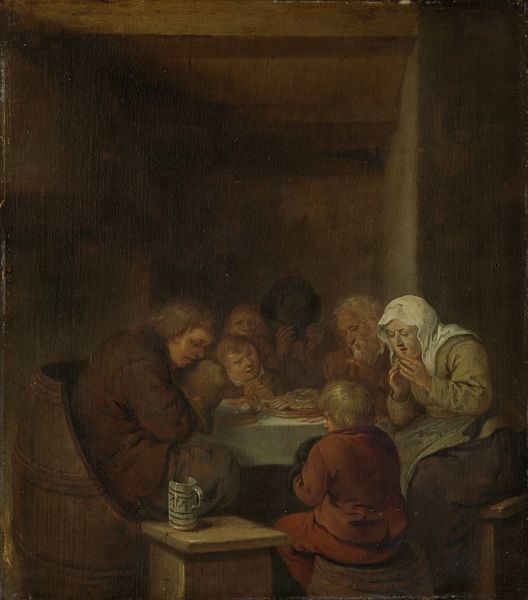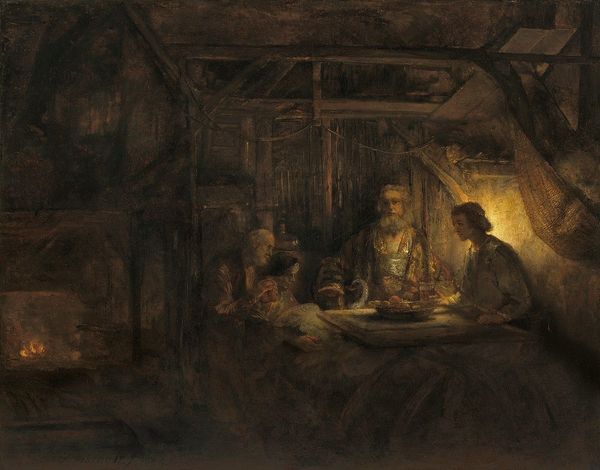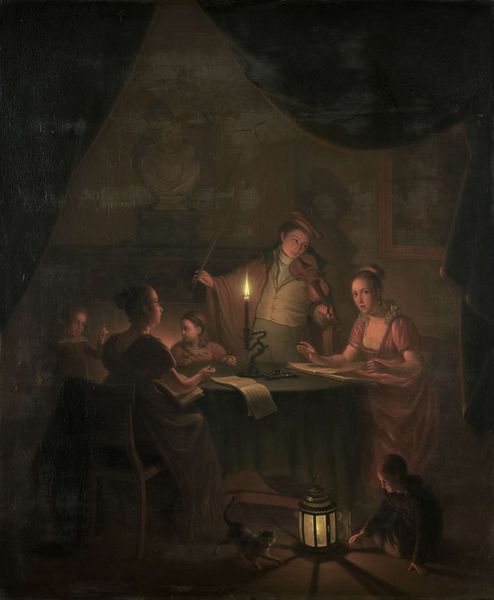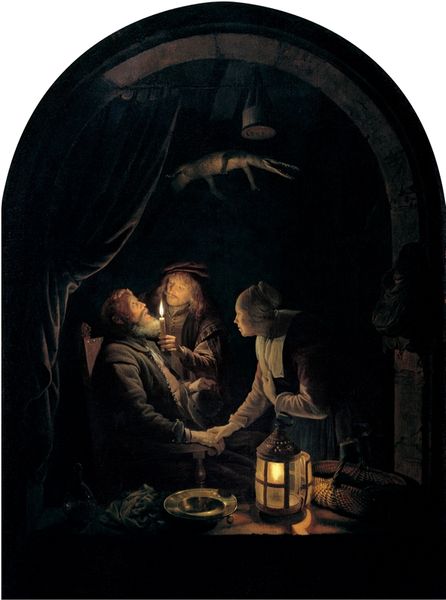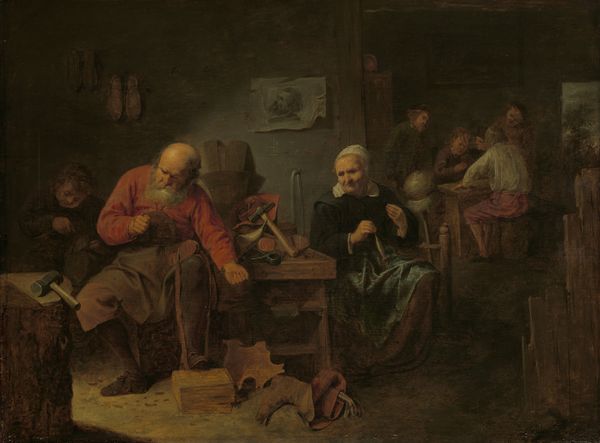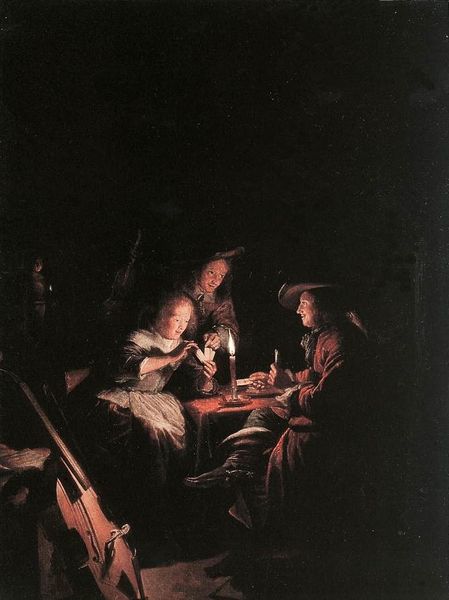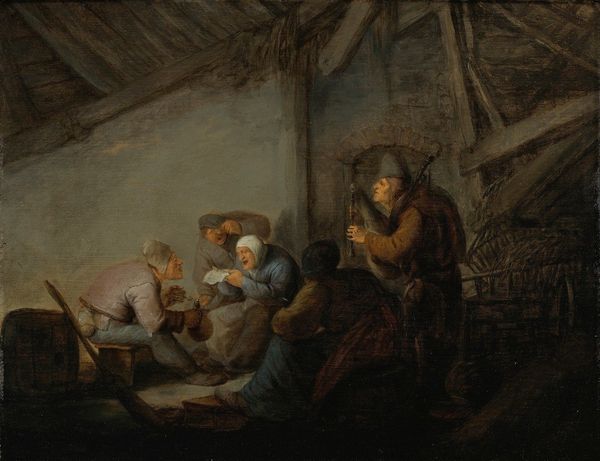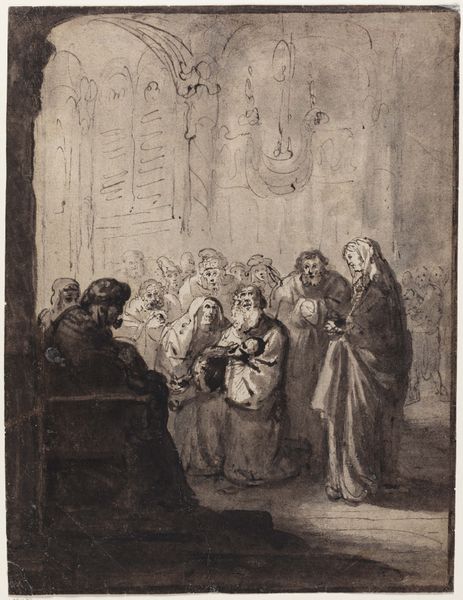
painting, oil-paint, canvas
#
baroque
#
painting
#
oil-paint
#
canvas
#
underpainting
#
chiaroscuro
#
genre-painting
#
history-painting
Dimensions: 89.5 cm (height) x 111.5 cm (width) (Netto), 108 cm (height) x 130.2 cm (width) x 6.5 cm (depth) (Brutto)
Curator: Welcome. We are standing before "Supper at Emmaus," an oil on canvas crafted by Rembrandt van Rijn around 1648. Art Historian: The scene is immediately striking! The theatrical use of light and shadow—chiaroscuro—casts a powerful, almost spiritual aura. It seems as though the figures emerge from darkness into a shared moment of illumination. Curator: Indeed. Rembrandt often employed this technique to heighten drama and focus on key figures, especially those from marginalized communities. Here, the focus on light underscores the revolutionary potential of recognizing the divine in the everyday. Consider that the figures surrounding Jesus are ordinary travelers. Art Historian: The figures embody a quiet awe. Observe how the man on the left gestures in apparent revelation as his companion stares. Rembrandt’s skill here draws from centuries of symbolic representation of moments of insight. The almost halo-like light around Jesus evokes the spiritual unveiling occurring. Curator: This depiction offers insight into class and identity politics of 17th-century Dutch society. The scene presents a narrative where the sacred enters the realm of common laborers—breaking social hierarchies. How might the original audience have felt, faced with Christ embodied among working people? Art Historian: This image presents familiar tropes such as light as a symbol for revelation—but here there is the quietude, the gentle embrace of the familiar. It evokes the sensation of revelation through simplicity and a feeling of intense shared interiority. We can note here the significance of food as sacrament in itself: the act of breaking bread becomes sacred, laden with cultural memory. Curator: That sense of interiority humanizes religious narrative, positioning this artwork in conversation with liberation theologies emphasizing the individual’s relationship with faith outside of dogma. It asks us, who do we invite to share bread? Art Historian: Thinking about that invites a fascinating psychological consideration of collective revelation and faith: do we expect the divine to come on clouds and thunder, or is it found when we have space to pause from the world around us and sit at the common table? Curator: Analyzing such a rich image reminds me that art gives insight into how cultures grapple with their ideals, and this is more true today than it ever has been. Art Historian: It encourages consideration that insight often waits for us in simple shared moments, revealed through persistent cultural symbols and archetypes.
Comments
statensmuseumforkunst almost 2 years ago
⋮
The Bible relates the story of two disciples who travelled from Jerusalem to the town of Emmaus following the death of Christ. During their travels they meet a stranger who joins them. When arriving at the town they go to an inn where Christ – for it is he – takes the bread, blesses it and breaks it. Only then do the disciples realise that the stranger is Christ risen from the dead. The divinity of Christ is revealed This scene shows the moment where the divinity of Christ is revealed to the disciples (Luke 24: 30-31). Their fright and reverence contrast sharply with the calm and serene demeanour of Christ. The painting's symbolic light With his characteristic use of symbolic light, Rembrandt lets Christ light up the dark space lit by a candle brought in by an unsuspecting kitchen hand. The illusionistic curtain painted in the left-hand side of the picture has been drawn back, accentuating how the scene represents the unveiling of a miracle. The authenticity of the painting The authenticity of this picture has been the object of some debate in recent decades. Many factors indicate that it was painted by assistants in Rembrandt’s workshop on the basis of studies by the master and under his supervision.
Join the conversation
Join millions of artists and users on Artera today and experience the ultimate creative platform.

